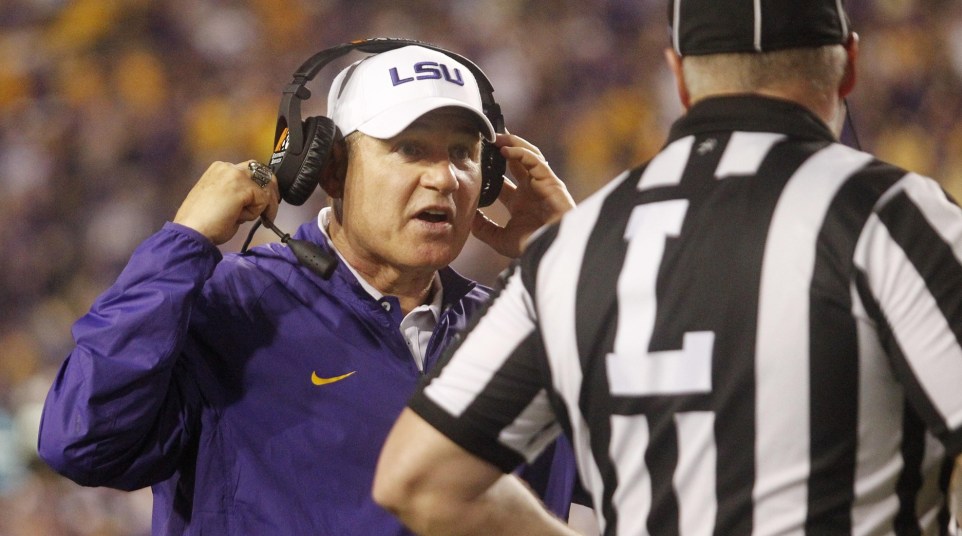
One stat each SEC West team needs to change in 2016
In the thick of the preseason, the SEC favorites are scheming to stay on top and the bottom-dwellers are figuring out ways to improve. As each SEC West school looks at the state of its team heading into 2016, there is always a focus area to improve. Here’s a stat from each team from 2015 that really needs to change if the team wants to stay on top or work their way up the ladder, and an explanation of how the team might correct it.
Alabama: 50
Finding a flaw in Alabama is like finding a mole on a beauty pageant contestant. Nonetheless, if you study long enough, a few things do stand out. Alabama converted only 50 percent of their 4th-down opportunities in 2015 (12 of 24).
With a new QB under center and an heir to Derrick Henry lining up in the backfield, Alabama can make its path to a repeat much easier by converting fourth downs. The Tide was 1-for-4 in its sole loss last season. Leaning more heavily on spring game star RB Damien Harris and possibly dual-threat QB Jalen Hurts gives Bama a means to improve on their fourth-down success in 2016, which could be a hidden key to the team’s hopes of repeating at champs.
Arkansas: 275.2
There was a time when winning the SEC West meant controlling the line of scrimmage in the running game. Heading into 2015, many believed that was still the case. With Leonard Fournette and Derrick Henry in the division, defensive coordinators were undoubtedly focused on stopping the run.
But (most) SEC West teams learned to pass as well, and Arkansas’s 275.2 passing yards allowed per game certainly speaks to that trend. The Razorbacks ended up 116th in the FBS in allowing offenses to throw the ball up and down the field. In 2016, former Iowa State head coach Paul Rhoads is tasked with improving the secondary, and one sleeper is sophomore Willie Sykes, who had a couple of big plays in coverage in the Razorbacks’ spring game.
Auburn: 44.9
Auburn’s offense, with disappointing signal-caller Jeremy Johnson, was widely viewed as the team’s Achilles heel in 2015. However, don’t tell that to the defense. Auburn allowed opponents to successfully amass a 44.9 percent conversion rate on 3rd down, good for 109th in the FBS rankings.
New defensive coordinator Kevin Steele has emphasized improved tackling, and in the spring game, the Tiger D held the offense to 1-for-22 on 3rd down. So either the Auburn defense is showing signs of great improvement or the offense has serious reason to worry.
LSU: 8
With all-everything RB Leonard Fournette, the Tigers may not only have the best player in the conference, but perhaps the odds-on favorite for the Heisman Trophy. So can LSU just hand the ball to Leonard and get out of his way?
If 2015 is any indication, not so much. LSU averaged eight penalties per game, tied for 119th in the NCAA. In particular, offensive line coach Jeff Grimes — in his third year for the Tigers — has to make sure his unit is aligned correctly and avoids costly holds, clips or other fouls. If LSU can remain in 2nd-and-short or 3rd-and-short, Fournette will break off highlight reel plays, sooner or later. If the Tigers again let penalties force them into 2nd-and-long or 3rd-and-long, LSU takes the ball out of Fournette’s hands and places victory or defeat on the comparatively unsteady shoulders of QB Brandon Harris.
Mississippi State: 26:16
Over the past four seasons, Dak Prescott righted a lot of wrongs for the Bulldogs, but Dak is off to the NFL. That means Dan Mullen will have to find other playmakers to pick up the slack in order for Mississippi State to hold its own in the supercharged SEC West.
Even with Prescott, MSU averaged just 26:16 in time of possession, which was 122nd in the NCAA last year. But now on 3rd-and-short, Mullen has to come up with something other than spreading the offense out and allowing Prescott to improvise. A key for the Bulldogs may be versatility. MSU auditioned various possible QBs in the spring with four different Bulldogs holding a legitimate shot at replacing Prescott. Mullen has always been a coach who can draw up some blackboard magic, and being able to shift around playmakers like Brandon Holloway or Gabe Myles may allow Mullen to scratch out enough yardage from enough different positions to rest his defense better in 2016.
Ole Miss: 17.7
Ole Miss was an offensive juggernaut in 2015, averaging over 500 yards per game and moving the ball almost at will. Still, one area that the Rebels struggled in was kick returns, where their 17.7 yards per return was 119th in the NCAA.
Chad Kelly and many of Ole Miss’ top playmakers will return, but they can be even more effective when not faced with a long field on most drives. A name to watch for the fall is redshirt freshman DB Jalen Julius, who may be the needed spark on kick returns.
Texas A&M: 213.7
Defensive coordinator John Chavis came to A&M to add respectability to Kevin Sumlin’s defense, and he made significant strides in 2015. The Aggies knocked nearly 70 yards per game off their total defense stats from 2014, but one area that Chavis didn’t help was run defense.
A&M allowed 213.7 rushing yards per game in 2015, which was 107th among FBS programs. A&M has been 110th and 109th in the stat over the two years before that, so the pattern is hardly new. Chavis will rely on better production from his linebackers, and a key player is sophomore Otaro Alaka, who played little in 2015 because of injuries. If Alaka can help stop the run, watch out for A&M in 2016.
